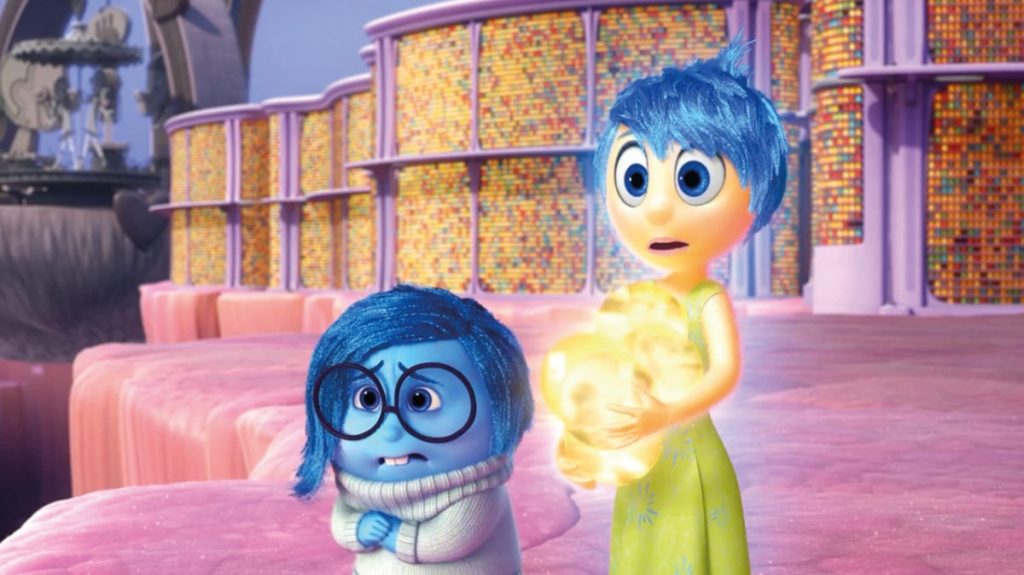“Do you ever look at someone and wonder, ‘What is going on inside their head?’” Director and producer of Disney-Pixar’s award-winning triumph Inside Out (2015) Pete Docter pondered the same idea.
In an interview, Docter admitted that it was his daughter, Ellie, who sowed the initial seeds of inspiration for the story. When she turned 11, the filmmaker noticed that his previously effervescent daughter had become quieter, moodier. His desire to know the reasons for the change in her mannerserved as the catalyst for the film’s creation.
Inside Out follows happy-go-lucky 11 year-old Riley and the emotions living inside her head: Joy, Fear, Anger, Disgust, and Sadness. When Riley and her family move to San Francisco, Joy’s desire to keep Riley happy throws all five emotions out of balance. When Joy and Sadness are accidentally sucked into the far recesses of Riley’s mind, Riley must manage the stress of the move with only Fear, Anger, and Disgust to guide her.
Inside Out is a masterpiece, not only in terms of its vibrant animation that nearly pops from the screen, character design, and great writing, but in its intelligent portrayal of child psychology and what happens when a pre-teen’s life is fundamentally shaken.
Turning Joy Inside Out
Docter and co-director Ronnie del Carmen consulted with numerous psychologists and neuroscientists during the development of the film. Psychologists Paul Ekmen and Dacher Keltner, whom Docter and del Carmen conferred with, discussed how the film emphasises the ways emotions organise our thoughts and social lives, focusing particularly on the role of sadness in fostering connections.
From the moment Joy begins her narration and steps into baby Riley’s headspace, we identify her as the unspoken ‘leader;’ the kind reminiscent of those we might have found in group projects or organised games when we were kids. We’re not sure how they ended up being the ones bossing us around, but it happened, and they seem pretty good at it, so we let it go.

Joy’s job is to keep Riley happy, a task which often puts her at odds with Sadness, played with a hilarious dour melancholy by Phyllis Smith. At one point, Joy even chalks a ‘circle of sadness’ to contain the ‘wayward’ emotion. But sadness has a way of coming out eventually.
Joy is a charming character, who is so light and happy that she emanates a soft glow. But her attempts to keep Sadness (and, to an extent, the remaining emotions) at bay in light of s request that her daughter, ‘keep smiling,’ and remain their ‘happy girl,’ often veer sharply into the lane of toxic positivity.
‘Be Happy’
In the 2010s and even before, toxic positivity was branded into our busy lives, because we were taught that happiness the pinnacle of our emotional experience. The phenomenon even spread to the fashion world; until fairly recently T-shirts sporting the sickeningly superficial affirmations, ‘be happy’ or ‘good vibes only’ permeated the rails of most clothes stores.
Cut to now, and for the most part we have learned that toxic positivity doesn’t work. In early 2024 senior therapist Sally Baker said: “‘Toxic positivity doesn’t allow you to feel your full spectrum of emotions. Some people are so afraid of their darker or more negative emotions that they put a lot of energy into staying really positive.”

A 2017 study conducted in the US found that those who accept rather than judge their mental experiences experience more positive health outcomes. On the flip side, people who avoided their negative feelings or who judged themselves harshly for having them were more likely to report mood disorders or distress six months later.
Achieving Balance
There’s a moment in the film, Sadness reproach herself for nearly touching the core memories (thereby making them sad), when Joy declares, “You can’t focus on what’s going wrong. There’s always a way to turn things around, to find the fun!”
This is a perfect set up for what happens later. As the film goes on to point out, and as Joy later finds, sometimes you do need to focus on what has gone wrong, so you can process what you are feeling and work through the issue in a healthy way.

The film’s creators at first struggled to find the balance between Joy’s cheerful nature and the mess manipulates in Riley. What they achieved in the finished product, however, is an ideal equilibrium. Though Joy is culpable in her shortsighted and increasingly neurotic attempts to push Sadness aside, as an audience we can understand and even on some level identify with her actions because at her core she just wants the best for Riley.
All of which perpetuates the notion that toxic positivity can mean well, despite being detrimental to our wellbeing in the long-term.
Embracing Sadness
It was during the film’s early development that Docter realised Sadness was the key. In an interview about the film, the director said: “Joy, as much as we all want it in our lives, is not the answer. The answer is actually sadness.
“That realisation felt like an epiphany at the time but it was actually where we started.”
Even in 2024, many of us still perceive sadness as an inherently negative emotionone that should be brushed aside or avoided at all costs. But in the film it is only by embracing sadness that is able to reconnect with her family and find a bittersweet kind of joy in this.
And that is the most beautiful part of the film. As family therapist Johnathan Decker says on the popular YouTube channel Cinema Therapy, “[Inside Out] teaches us to embrace sadness as a means of being close and developing compassion and empathy, and how that builds relationships in a way that nothing else really can.”
Aside from being vastly entertaining, the film offers intriguing and digestible insights into the workings of the mind. Most significantly, it teaches children and adults the importance of experiencing the full spectrum of their emotions, even the negative ones. Without sadness, we are numb to joy.
The upcoming Inside Out 2 will hopefully be another Pixar gem, but the original will always endure as a thought-provoking meditation on the importance of allowing ourselves to experience every human emotion.
Words by Faye Price
Support The Indiependent
We’re trying to raise £200 a month to help cover our operational costs. This includes our ‘Writer of the Month’ awards, where we recognise the amazing work produced by our contributor team. If you’ve enjoyed reading our site, we’d really appreciate it if you could donate to The Indiependent. Whether you can give £1 or £10, you’d be making a huge difference to our small team.
